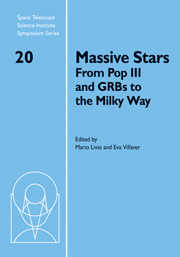Book contents
- Frontmatter
- Contents
- Participants
- Preface
- High-mass star formation by gravitational collapse of massive cores
- Observations of massive-star formation
- Massive-star formation in the Galactic center
- An x-ray tour of massive-star-forming regions with Chandra
- Massive stars: Feedback effects in the local universe
- The initial mass function in clusters
- Massive stars and star clusters in the Antennae galaxies
- On the binarity of Eta Carinae
- Parameters and winds of hot massive stars
- Unraveling the Galaxy to find the first stars
- Optically observable zero-age main-sequence O stars
- Metallicity-dependent Wolf-Rayet winds
- Eruptive mass loss in very massive stars and Population III stars
- From progenitor to afterlife
- Pair-production supernovae: Theory and observation
- Cosmic infrared background and Population III: An overview
Cosmic infrared background and Population III: An overview
Published online by Cambridge University Press: 04 August 2010
- Frontmatter
- Contents
- Participants
- Preface
- High-mass star formation by gravitational collapse of massive cores
- Observations of massive-star formation
- Massive-star formation in the Galactic center
- An x-ray tour of massive-star-forming regions with Chandra
- Massive stars: Feedback effects in the local universe
- The initial mass function in clusters
- Massive stars and star clusters in the Antennae galaxies
- On the binarity of Eta Carinae
- Parameters and winds of hot massive stars
- Unraveling the Galaxy to find the first stars
- Optically observable zero-age main-sequence O stars
- Metallicity-dependent Wolf-Rayet winds
- Eruptive mass loss in very massive stars and Population III stars
- From progenitor to afterlife
- Pair-production supernovae: Theory and observation
- Cosmic infrared background and Population III: An overview
Summary
We review the recent measurements on the cosmic infrared background (CIB) and their implications for the physics of the first-stars era, including Population III stars. The recently obtained CIB results range from the direct measurements of CIB fluctuations from distant sources using deep Spitzer data to strong upper limits on the near-IR CIB from blazar spectra. This allows us to compare the Population III models with the CIB data to gain direct insight into the era of the first stars, the formation and evolution of Population III stars, and the microphysics of the feedback processes in the first halos of collapsing material. We also discuss the cosmological confusion resulting from these CIB sources and the prospects for resolving them individually with NASA's upcoming space instruments, such as the James Webb Space Telescope (JWST).
Introduction
The very first stars to form in the universe, commonly called Population III stars, are now thought to have been very massive stars forming out of primordial metal-free gas at redshifts exceeding z ∼ 10 (see review by Bromm & Larson 2004). Assuming that the density field responsible for structure formation is given by the ∧ Cold Dark Matter (CDM) model, the first collapsing haloes hosting such stars may be too faint to be observed with present telescopes. Their studies may, however, be possible via the cumulative radiation emitted by the first luminous objects, most of which has by now been shifted into the near-IR wavelengths of ∼1–10 μm.
- Type
- Chapter
- Information
- Massive StarsFrom Pop III and GRBs to the Milky Way, pp. 228 - 241Publisher: Cambridge University PressPrint publication year: 2009
- 1
- Cited by



